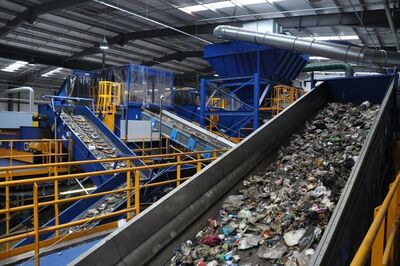Material Recovery Facility
A Material Recovery Facility is often referred to as a ‘MRF’ and is generically a facility that sorts, grades and prepares waste fractions suitable for onward dispatch to a Reprocessor.

Overview
A Material Recovery Facility is often referred to as a ‘MRF’ and is generically a facility that sorts, grades and prepares waste fractions suitable for onward dispatch to a Reprocessor. Many also refer to a MRF as a Material Recycling Facility, which is not strictly true in that the MRF separates the material for onward recycling rather than recycling the material in its own right.
The key elements of MRF design and operation include:
- Throughput capacity - measured in both weight and volume due to differing bulk densities of materials that impact on the design of the sorting machinery, capacity of conveyors and storage areas
- Reliability - the operational availability of the plant and the time required to maintain it
- Quality of Outputs - high quality outputs ensure a solid, higher value market for the materials recovered
- Adaptability - the ability to adjust to changing inputs over time
In all of these factors, the quality of the input materials clearly has a major influence. Poor quality materials, or materials that are heavily contaminated at the input stage, can lead to lower quality outputs and/or higher levels of rejects as part of the process.
Types of MRF
There are essentially four broad types of MRF:
- "Single-Stream" MRFs that are focused on one recyclate stream, removing any contamination/contrary materials from that material to produce a high quality recyclate with high value.
- "Clean" MRFs that are focused on Dry Mixed Recyclables (DMR). They remove contamination/contrary materials of up to c. 20% in the input mix (in the worst cases) and produce a variety of separate good quality recyclate streams with less than c.2% contrary materials with good value.
- "Dirty" MRFs/Waste to Fuel MRF which extract some recyclate from mixed MSW and Commercial Waste streams with more of a focus on producing a Waste Derived Fuel (WDF). Recyclate tends to be of poor quality and of lower value.
- Material specific MRFs for example:
- Construction and Demolition Waste and skip wastes.
- Waste Electrical and Electronic Equipment
- Plastic materials and purpose designed PRFs (Plastics Recovery Facility or Plastics Recycling Facility)
"Clean" MRFs
"Clean" MRFs accept materials from source separation schemes and Dry Mixed Recyclables (DMR). A pictorial overview of one type layout/configuration is shown below for multiple streams of DMR, whereas a single stream or twin stream input would have a far more straightforward layout[1]:
| 1. Material Feed - often delivered via a Bag Breaker | |
| 2a.Trommel/Trommel Screen - normally used to separate off the larger, lighter mixed paper and cardboard fractions from the other materials | |
| 2b.Ballistic Separator - normally used to separate 2-dimensional light and flat items (such as paper and cardboard) from 3-dimensional heavier rigid items such as glass bottles and cans | |
| 3a.Magnetic Separator - used to separate steel cans/ferrous metals | |
| 3b.Air Separator/Air Classifier - used to separate heavy from light materials, in this case to remove contamination from the glass fraction | |
| 4.Eddy Current Separator - used to separate aluminium cans/non-ferrous metals | |
| 5.NIR Optical Sorting - Near Infra Red (NIR) light is used to separate materials, often focused on different plastic types/polymers |
The MRF Code of Practice applies to all 'Qualifying MRFs' which are those all those MRFs that receive more than 1,000 tonnes per annum of primarily DMR materials from households and other sources with a similar composition. This has allowed the performance of MRFs to be compared, including the level of contamination and associated rejects from each MRF. A full list of these sites can be found on the page Qualifying MRFs.
"Dirty MRFs"
content to follow
Material Specific MRFs
Construction and Demolition Waste and Skip Wastes
content to follow
Waste Electrical and Electronic Equipment
content to follow
Plastic Materials and Purpose Designed PRFs
content to follow
References
- ↑ Suez Recycling and Recovery UK
